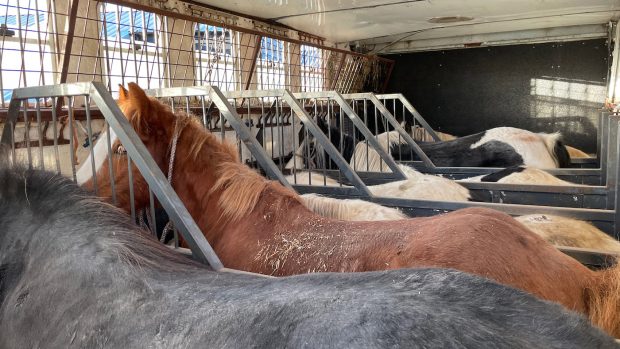It’s the last day of a very long journey. I wake up shattered, despite managing a good eight hours’ sleep — I can’t imagine how those horses feel.
We drive for two hours towards the Italian coastline. Suddenly, the temperature soars — it’s 30c by the time we reach the staging post at Trieste, on the border with Italy and Slovenia.
Trieste staging post
The chief vet Manlio Palei and staging post manager Luigi “Gigi” Marrocco greet us openly. They know Jo from before, as does the man looking after the horses. Four lorries arrived yesterday from Poland, and are in a clean barn, well bedded with thick straw, cooled by fans. They have plentiful hay and are watered every three hours.
Despite the good conditions, we see signs of severe exhaustion — one palomino is so tired he is neither eating nor drinking. Even when I touch him, he barely registers.
Others have cuts, rubbed tails, and are shifting their weight from leg to leg, unable to get comfortable.
They are all so beautiful — I can’t spot one ugly, common-looking horse among the 100-odd there. Flaxen manes and tails, palominos, liver chestnuts, bright bays, duns — I imagine them in a show-ring at home. It’s heart-breaking.
Gigi says they see about 10 horse trucks per week, all of them Polish transporters, occasional Italian or Croatians, but no Romanian (despite it being the second biggest exporter of horses for slaughter in Europe). An average of 2,000 horses stop here each year.
Manlio says the live horse trade is decreasing, and thanks to the new regulations, they are now seeing fewer problems. But — the horses here are the lucky ones. If 2,000 are stopping here from a total of 84,000 coming into Italy each year — think how many go without the rest they should legally have.
A look inside a lorry
We’re shown by one Polish driver around his lorry — it can hold 18 horses, and is the best transporter in the business. He says it holds 300ltr of water, the buckets are clean and obviously used, it has plenty of straw inside and he has pitchforks and brooms neatly tied to the roof. I feel encouraged that some transporters are adhering to the law.
But I’m startled by how confined the partitions are — the driver indicates that it has two settings for bigger horses, but even then, there’s barely room for me inside, I can’t imagine how a horse feels standing pinned in for 24hours.
Jo says that before the regulations came in, lorries carried 25 to 28 each. With partitions, they average 18-20.
Last stopping post
We drive 40min north to Gorizia, a different facility altogether. This is also a customs and excise point, and we have just 15 minutes to look around, though we’re permitted to film and take photographs. We are asked to don plastic boots first, and then look around the barns of horses. There are five trucks here, all from Poland again.
This time, the horses aren’t in such good shape — they look shattered, dehydrated and utterly broken. I see cuts, snotty noses and desperately unhappy animals.
As Jo and I walk through one barn, I touch a couple on the nose. After everything they’ve been through, they come forward, ears pricked, asking me what I can offer. It breaks my heart.
Jo puts her hand on one horse’s face, and he lowers his head. Tears fill her eyes and I hear her repeat to herself: “don’t touch them Jo, don’t touch them.”
Horse after horse, I photograph and apologise to. “I’m sorry for what humans are doing to you, I’m so sorry.”
One lorry, loaded with horses, pulls past me. It’s the most haunting sight of the trip yet — a row of heads, ears all pricked, looking out of the side. They’re wondering, in that horsey way, where they are going — expectant and interested. They have no idea. I feel very sick.
We make our thank yous and leave. At a garage just down the road we stop to refuel, pick up water — it’s now 32c and very humid — and film the ending to my video diary.
The lucky horses will have just a four or five-hour drive to a slaughterhouse in Northern Italy — others could be bound for Sicily, and have a 12hr journey and boat trip to contend with before reaching their fate.
In front of the camera, I find it hard to express how I feel. I am utterly flat and let down that this trade goes on. I’ve no idea whether I convey this adequately in what I say, sitting in the front seat of the car that has been our home for five days. We’ve slept, eaten, and drank adequately along the way and we are all shattered.
And we do much worse to horses.




